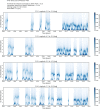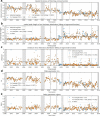Regime shift in Arctic Ocean sea ice thickness
- PMID: 36922610
- PMCID: PMC10017516
- DOI: 10.1038/s41586-022-05686-x
Regime shift in Arctic Ocean sea ice thickness
Abstract
Manifestations of climate change are often shown as gradual changes in physical or biogeochemical properties1. Components of the climate system, however, can show stepwise shifts from one regime to another, as a nonlinear response of the system to a changing forcing2. Here we show that the Arctic sea ice regime shifted in 2007 from thicker and deformed to thinner and more uniform ice cover. Continuous sea ice monitoring in the Fram Strait over the last three decades revealed the shift. After the shift, the fraction of thick and deformed ice dropped by half and has not recovered to date. The timing of the shift was preceded by a two-step reduction in residence time of sea ice in the Arctic Basin, initiated first in 2005 and followed by 2007. We demonstrate that a simple model describing the stochastic process of dynamic sea ice thickening explains the observed ice thickness changes as a result of the reduced residence time. Our study highlights the long-lasting impact of climate change on the Arctic sea ice through reduced residence time and its connection to the coupled ocean-sea ice processes in the adjacent marginal seas and shelves of the Arctic Ocean.
© 2023. The Author(s).
Conflict of interest statement
The authors declare no competing interests.
Figures













References
-
- Fox-Kemper, B. et al. Ocean, cryosphere and sea level change. IPCC Climate Change 2021: The Physical Science Basis (eds Masson-Delmotte, V. et al.) (Cambridge Univ. Press, 2021).
-
- Druckenmiller, M. L., Moon, T. & Thoman, R. (eds) State of the Climate in 2020: The Arctic. Bull. Am. Meteorol. Soc. 102, S263–S315 (American Meteorological Society, 2020).
-
- Frey KE, Moore GWK, Cooper LW, Grebmeier JM. Divergent patterns of recent sea ice cover across the Bering, Chukchi, and Beaufort Seas of the Pacific Arctic Region. Prog. Oceanogr. 2015;136:32–49. doi: 10.1016/j.pocean.2015.05.009. - DOI
Publication types
LinkOut - more resources
Full Text Sources

